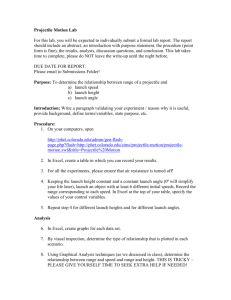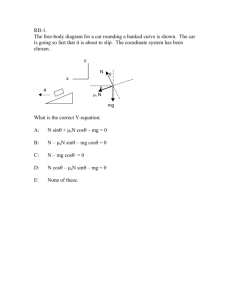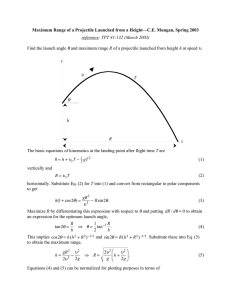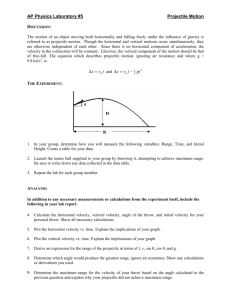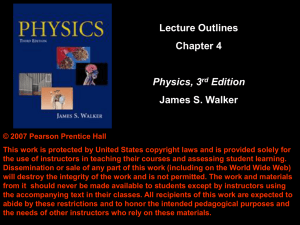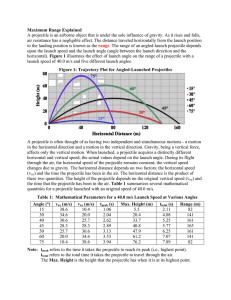SP221/2141&4341 Chapter 3 Homework Due Monday September 19, 2016
advertisement
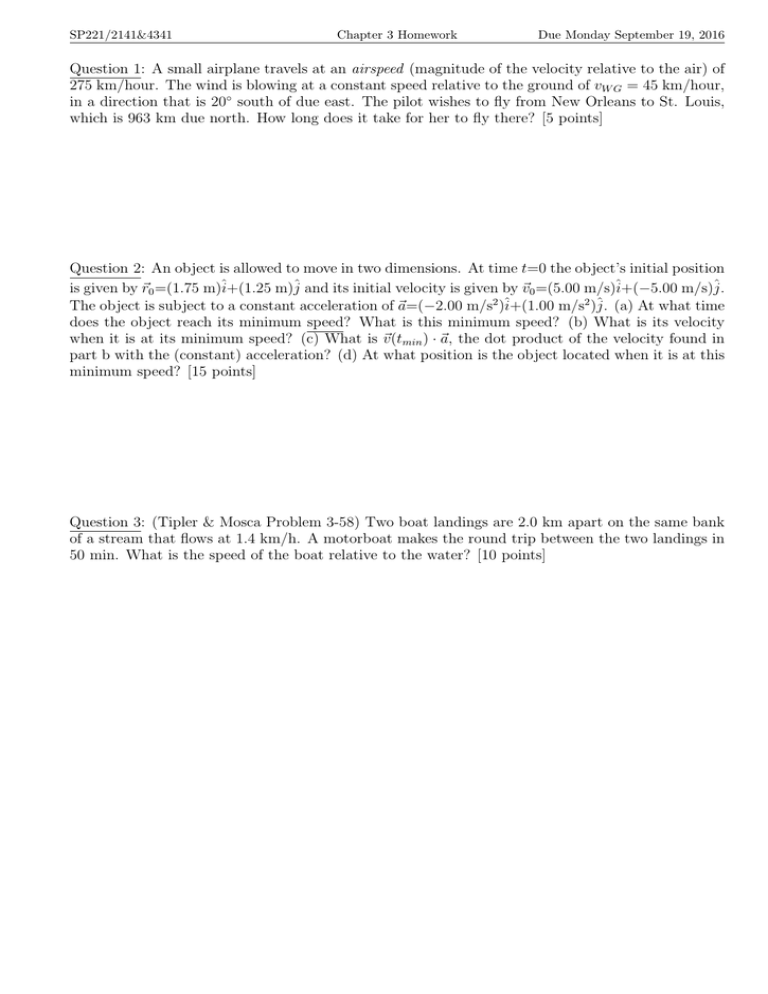
SP221/2141&4341 Chapter 3 Homework Due Monday September 19, 2016 Question 1: A small airplane travels at an airspeed (magnitude of the velocity relative to the air) of 275 km/hour. The wind is blowing at a constant speed relative to the ground of vW G = 45 km/hour, in a direction that is 20◦ south of due east. The pilot wishes to fly from New Orleans to St. Louis, which is 963 km due north. How long does it take for her to fly there? [5 points] Question 2: An object is allowed to move in two dimensions. At time t=0 the object’s initial position is given by ~r0 =(1.75 m)î+(1.25 m)ĵ and its initial velocity is given by ~v0 =(5.00 m/s)î+(−5.00 m/s)ĵ. The object is subject to a constant acceleration of ~a=(−2.00 m/s2 )î+(1.00 m/s2 )ĵ. (a) At what time does the object reach its minimum speed? What is this minimum speed? (b) What is its velocity when it is at its minimum speed? (c) What is ~v (tmin ) · ~a, the dot product of the velocity found in part b with the (constant) acceleration? (d) At what position is the object located when it is at this minimum speed? [15 points] Question 3: (Tipler & Mosca Problem 3-58) Two boat landings are 2.0 km apart on the same bank of a stream that flows at 1.4 km/h. A motorboat makes the round trip between the two landings in 50 min. What is the speed of the boat relative to the water? [10 points] SP221/2141&4341 Chapter 3 Homework Due Monday September 19, 2016 Question 4: We wish to launch a projectile with a horizontal range R that will land on a plateau that is at a height H higher than the point from where we launch. (a) What is the minimum launch speed v0 needed to hit the target? (Note: you do not know θ0 .) For calculational ease, we will instead solve for the square of the minimum possible launch speed, (v0,min )2 . Express your answer only in terms of of g, H, and R. [20 points] H θ0 R Hints: Much like with the in-class example, you will want to use the equation R = v0 cosθ0 t to solve for a variable that will be substituted in to your vertical motion equation. However, do not solve this for t: it will work, but the algebra will get very messy. Instead use this equation to solve for θ0 in a way such that sinθ0 can be eliminated from your vertical motion equation. Use the right triangle shown below to do this. At this point you can solve for v02 as a function R, H, g, and t. Take the derivative with respect to t to determine the minimum possible value of v02 . v 0t p (v0 t)2 − R2 R (b) Once you’ve solved for (v0,min )2 as a function of g, H, and R consider a few limits. What is v0,min when H=0? It should match the value derived in class. What is v0,min when R=0 and H is positive? What is v0,min when R=0 and H is negative? See if those answers make intuitive sense; if not you might have made an algebra error somewhere. SP221/2141&4341 Chapter 3 Homework Due Monday September 19, 2016 PROGRAMMING PROBLEM Question 5: Now consider a situation similar to that in Question 4. You wish to launch a projectile at a fixed speed v0 and the projectile will land on a plateau that is a height H above the launch point. Assume that the projectile passes through its highest point and is on its way down when it hits the ground. At what angle θ0 should the projectile be launched in order to maximize the range, R? It is probably possible to solve this in closed form as we did in Question 4, but it would be quite difficult. So instead write a computer program so solve this. For all cases, use v0 =5 m/s and g=9.81 m/s2 . (a) What angle maximizes the range if H=0 m? What is this maximum range? (b) What angle maximizes the range if H=0.75 m? What is this maximum range? (c) What angle maximizes the range if H=1.274 m? What is this maximum range? (Note, this height is chosen to v2 be just very slightly smaller than 2g0 =1.27421 m. Think about the significance of this height.) (d) What angle maximizes the range if H=−1000 m? (i.e. You are standing at the edge of a cliff that is 1 km high.) [20 points] v0 H θ0 =? Maximize R Give your answer with an accuracy of 0.1◦ (i.e. Iterate through your program in steps no larger than that.) In Matlab, sin(x) and cos(x) assume that the argument is given in radians while sind(x) and cosd(x) assume that the argument is given in degrees. Here’s a possibly useful function: [C,I]=max(A) returns the maximum value of the elements in array A as C and the index of that element as I. So if A=[1, 3, 6, 7, 8, 11, 13, 12, 8, 6] then [C,I]=max(A) will return C=13 and I=7 because 13 (the largest number in that array) is located as the 7th element.


